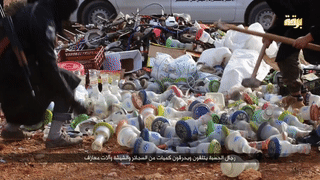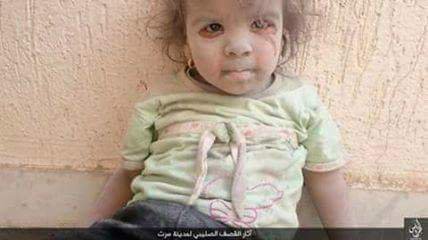So-called Islamic State was ousted from the Libyan city of Sirte in late 2016 by joint US and Government of National Accord forces. Using materials uncovered as part of a major new project tracking airstrikes and civilian harm in Libya, Airwars recounts the rise and fall of the terror organization through the eyes of local citizens, journalists and fighters. A version of this feature also appeared in the Daily Beast.
During its short occupation of Sirte, ISIS was often keen to film and then propagandise its actions.
In one video released on the terror group’s Telegram channel, heavily armed Al Hisbah ‘enforcers’ stalk through a Sirte marketplace, demanding that local people stop trading after the call to prayer. The ISIS police then check vendors for banned items – on the lookout for books about the devil, sex and desire.
In the next scene, ISIS fighters can be seen gleefully destroying their discoveries – smashing shisha pipes with hammers; and destroying cigarette cartons, and even a drum kit. All were forbidden at Sirte in this extreme interpretation of Islam – one in which Al Hisbah actively persecuted the local population.
Sirte had been the hometown of Libya’s former dictator Muammar Gadhafi, the once-feared leader ousted and slain in a bloody 2011 uprising. The power vacuum left by Gadhafi’s death – later described by Barack Obama as the greatest foreign policy mistake of his presidency – proved ripe territory for an expansive Islamic State, which by 2015 already controlled great swathes of Iraq and Syria.
Videos like those from 2015 and 2016, when ISIS ruled Sirte, depict how it established totalitarian rule in the city within a short period of time. Before then, a loose alliance between the rebel Libyan National Army (LNA), the militant group Libya Dawn and the Al Qaeda affiliated Ansar Al-Sharia had controlled the city between them. Yet their forces were quickly overrun by ISIS – in part due to the political turmoil which engulfed Libya following the collapse of the provisional government in late 2014.
“We forced the hijab on women and we caught the smugglers,” ISIS officials can be seen explaining to a small crowd of people. “We’re providing courses about Islam for prisoners and the people”. Religious education became mandatory in Sirte under ISIS rule.
Foreign fighters
Radical Islamism did not have a particularly strong tradition in Libya prior to NATO’s intervention, with the country deciding on a secular government in 2012. That meant ISIS had to supplement its local support by recruiting members from other countries, in order to consolidate Sirte as its Libyan stronghold. People from Tunisia, Chad, Mali, Sudan, Egypt, Algeria or Syria were offered what they believed to be the ideal environment to practice an extreme version of Islam.
Once it had seized the city, ISIS quickly established its own police force – introducing gender segregation at schools; banning alcohol; and introducing Draconian punishments such as cutting off limbs and beheading people. In its propaganda videos, the terror group proudly depicts crucifixions and the beheading of Christians. These savage punishments were usually followed by interviews with young ISIS members who described their motivations.
“This is a message to fight to all the Muslims in Libya – to fight the Jews and Crusaders. ISIS scares them by controlling more and more cities, and applying Sharia law”, a masked fighter brags in one video. His call to extremism is followed by footage of a tribunal against an alleged thief, which ends with the accused having his hand cut off.
Sometimes it appears no detail is too small to warrant the attention of ISIS’s thought police. Videos posted to the terror group’s Telegram account show Al Hisbah patrols obsessing over Western-made products in a local supermarket, including a bottle of Head and Shoulders shampoo.
Libya stronghold
ISIS had for a while had also established footholds in the Libyan cities of Sabratha and Derna. But airstrikes – and ground assaults from the more moderate Derna Shura Mujahideen Council – soon saw the terror group concentrated in just one city: Sirte.
At their peak, between 3,000 and 5,000 ISIS members reportedly controlled the city. Similar to its big brother in the Levant, ISIS’s presence in Libya sparked both local and international fear – this time of the jihadists spreading throughout Libya and then across North Africa. The internationally recognised Government of National Accord (GNA) of Libya reacted in May 2016 with the formation of the Al-Bunyan Al-Marsous operation (in Arabic, ‘Impenetrable Wall’), which immediately advanced on the city.
However after some initial success in gaining control over outer neighbourhoods of Sirte (reportedly with British special forces support), Al-Bunyan Al-Marsous struggled to break through ISIS’s inner line of defence – which heavily employed snipers and suicide attacks. This in turn prompted the GNA to request air support from the United States, which officially joined the battle on August 1st 2016.
With US air support the GNA was now able to advance more quickly, launching its Macmadas operation on August 12th. By the end of that month the troops had captured additionally neighbourhoods from ISIS – though the operation was briefly halted because of reported concerns for civilian lives.
ISIS suffered heavy losses in the attacks, including senior figures. Waleed al-Farjani, a senior judge of the Islamic court in Sirte was killed together with the Egyptian Abu Omar al-Muhajir on August 15th, for example.

Waleed al-Farjani in 2015 – killed a year later in a likely US airstrike (Image: Amaq via Al Marsad)
ISIS continued to lose its senior members in Sirte right up to the end. Fayez Al-Bidi, an imam from Benghazi, was reportedly killed in an airstrike around December 4th. Al-Bidi, a former leader of the Al Qaeda-affiliated Ansar al-Sharia, had fled from military operations against his previous organisation to Sirte – where he became a senior ISIS figure and was reportedly in charge of the terror group’s main prison.
Civilians at risk
While there is no doubt that much of Sirte was destroyed in the subsequent fighting – and that trapped civilians were harmed – there are still no reliable numbers on how many died.
Reporting on the military operation and on civilian harm was difficult for locals and journalists for various reasons. The Al-Bunyan Al-Marsous forces cut off communication channels, so that people trapped in the city could not reach the outside world. And only a small number of journalists had access to the battleground, which made critical reporting almost impossible.
Nonetheless, some people on both sides sides were able to capture aspects of the battle for Sirte – in doing so creating accounts of life in a city which would be almost completely destroyed in the expanding fight against ISIS.
The first known report of likely civilian harm from US strikes was published on August 12th 2016. Various sources claimed that a teenager named Mohammed al-Qadhafi [a variant spelling of Gaddafi] died as a result of an airstrike on his family home, near the Gulf Challenge School.
With the battle for the city now fully underway, Alsharq Al-Awsat reported on September 8th 2016 that civilians had become trapped in Sirte’s ‘600’ neighbourhood – and that ISIS was using them as human shields. The GNA’s forces brought a temporary halt to their operation – though the Libya Herald claimed that the interruption was due not to the risk of civilian harm, but because ISIS fighters had managed to get behind the GNA frontline.
Video of an airstrike on Sirte posted by Al-Bunyan Al-Marsous forces
ISIS desperately tried to fight off the advancing enemy during the campaign. It even reportedly used female snipers – a highly unusual move for the otherwise ultra- conservative terror group. Later Al Jazeera reported that the group was employing female suicide bombers as well.
Another credible report of possible civilian harm from the US-backed GNA assault came from Twitter on October 12th 2016. Majdi Alshrif and Hameda MK posted images of dead and injured children, which they claimed had been taken in the rubble of a collapsed house. On that same day the US self-reported ten airstrikes in Sirte, while local sources also described artillery shelling by Al-Bunyan Al-Marsous in the 600 neighbourhood.
Throughout the month of October there were repeated reports of civilians being trapped in besieged areas due to the lack of a safe passage. On October 21st, Ahmed El Sharkawy claimed on Facebook that women and children were trapped under rubble in the city. A week later, the assault had to be halted again, as ISIS was once more said to be using civilians as human shields according to GNA spokesperson Rida Issa.
In November, the fight for the remaining neighbourhoods of Sirte still under ISIS control intensified further – with the jihadists refusing to give up despite now being fully encircled by GNA troops. The besiegers in turn not only faced continued suicide attacks, booby traps and mines; but also had to avoid civilian casualties – including ISIS hostages and human shields. Asharq Al-Awsat quoted Rida Issa as saying that “[…] GNA troops could hear ‘the cries of civilians every time a strike is carried out’ but he did not know their number, only that ISIS had entrapped them.”
Women and children were among the victims – many of them family members of ISIS fighters. Al Aan TV interviewed Tasnim Alkhudry, a radicalised woman detained in a Sirte prison who gave a frank account of events in the besieged areas: “I was convinced by their ideology, so I moved to this city as my sister was living there. After living among them and losing our husbands, we discovered that ISIS members have engaged in hugely unacceptable behaviour.
“Apparently the Islamic State was not a genuine Islamic state that can protect vulnerable people like kids and women. The State was crossing the boundaries of fair behaviour. Therefore, when the war started in Sirte we were able to observe breaches of the rules of Islam – and the use of children and women as human shields.”
Al Aan TV interview with Tasnim Alkhudry
ISIS defeated
By December 6th 2016, ISIS was finally defeated at Sirte. It now became easier for journalists and investigators to gain access – with the significant damage to the city aloso now visible to all.
During the final days of the campaign and its immediate aftermath, the Al-Bunyan Al-Marsous forces reported saving hundreds of people from the rubble, including many children. Libya’s Channel published troubling footage of a small child wandering slowly out of a destroyed home, for example. Al Jazeera also showed powerful images of injured children receiving medical aid, and the many destroyed neighbourhoods of Sirte.
On December 16th, Elkul reported that the Misurata Central Hospital had received 47 injured children and 16 injured women during the whole campaign. And a few days later MC Doualiya published an article saying that “dozens of bodies are still under the rubble, the smell is very foul and it is feared that it will cause diseases such as plague,”. They quote a local citizen talking about unrecovered bodies: “There are terrorists, but also women and children who died of hunger and thirst under the rubble.”
Even so, there is still no official casualty count for those innocents caught up in the fighting at Sirte. AFRICOM ran the US air campaign which resulted in almost 500 strikes in 2016. When questioned about specific alleged civilian harm events during the battle, a spokesman told Airwars that “With regards to the specific incidents you highlighted and asked our team to review, they are not assessed as credible with the information currently available.”
Privately however, one senior US military official indicated to Airwars that civilian casualties from US actions may indeed have occurred at Sirte – but that no estimates could presently be reached based on the available evidence.
Libya’s Channel shows Al-Bunyan Al-Marsous forces rescuing families
The battle for Sirte again makes clear why tracking harm from the perspective of affected civilians themselves is so important. Local reporting clearly suggests that non-combatants weren’t just trapped in the city, but were actively held hostage in besieged neighbourhoods by ISIS. Even so, the US still conducted 495 airstrikes at Sirte, while its ground allies the GNA also conducted airstrikes as well as intense artillery shelling during the siege.
By Airwars estimates at least 37 civilians were killed and 69 more injured as a result of airstrikes during the campaign. To date, none of the belligerents have been willing to concede any civilian harm from any of their actions.
Media sources also reported around 2,500 ISIS fighters slain. Around 700 GNA fighters were also reported killed, and between 3,200 and 4,000 injured.
More than 18 months after the end of the Sirte campaign, some unclaimed bodies are still kept in refrigerated containers near Misurata. Families are often reluctant to be associated with relatives who fought with ISIS. Al Aan TV filmed the containers and said there were still hundreds of unidentified corpses within – some of them women and children.
Additionally, many children were reportedly left orphaned by the battle, with their parents said to have fought and died with ISIS. The scars left by ISIS’s brief occupation of Sirte – and the brutal assault to free the city – may be borne for generations to come.
Children orphaned by the fighting at Sirte were the subjects of an Al Jazeera report





